Tanztheater Wuppertal Pina Bausch returns to the Brooklyn Academy of Music (through September 24).
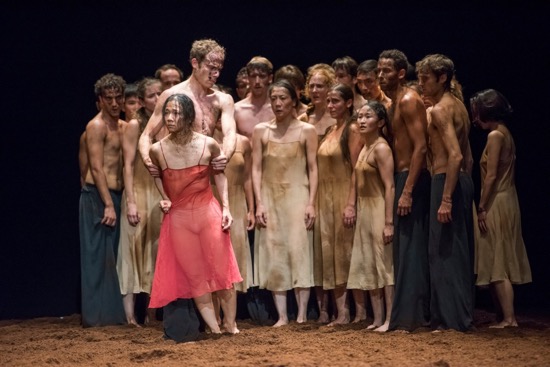
Julien Stierle and Tsai-Chin Yu watched by the celebrants in Pina Bausch’s The Rite of Spring. Photo: Stephanie Berger
Pina Bausch made a wise decision in 1984 when Tanztheater Wuppertal— the company she headed in that park-studded, industrial German city—made its New York debut at the Brooklyn Academy of Music: she introduced us to her stylistic preoccupations gradually. Between graduating from the Folkwangschule in Essen in 1958 and performing in the Folkwang Tanzstudio, directed by her former teacher Kurt Jooss, Bausch had spent a year studying at Juilliard and another year performing in the Metropolitan Opera Ballet and in works by Paul Sanasardo and Donya Feuer (plus once joining Paul Taylor in a duet). She may have understood the allure of movement and form in vanguard post-Cunningham circles. So her company’s Program A at BAM in 1984 consisted of her The Rite of Spring (1975) and Café Muller (1978). She was, so to speak, breaking us in. Her company performed in Brooklyn fourteen more times.
In these two pieces, unlike in her later ones, no one talked, no one sang, and no one chatted up spectators in the front row. No absurd games were played; no disturbing punishments developed (unless you count dancing yourself to death as punishment). In both Rite and Café Müller, dancing dominates, and emotion is conveyed by its timing, focus, and variegated dynamics. Still, those of us who saw Program A before we saw Program B could consider ourselves primed. Program B: Bluebeard (1977) and 1980—A Piece by Pina Bausch. We were ready to be amazed, outraged, thrilled, and provoked into laughter.
Watching Tanztheater Wuppertal Pina Bausch (re-named after Bausch’s death in 2009) perform revivals of The Rite of Spring (rehearsal directors: Barbara Kaufmann, Julie Shanahan, and Kenji Takagi) and Café Müller (rehearsal director Dominique Mercy, assisted by Bénédicte Billiet), I’m interested to see what I didn’t notice in 1984. I have changed, and perhaps, very subtly, so have the dances.
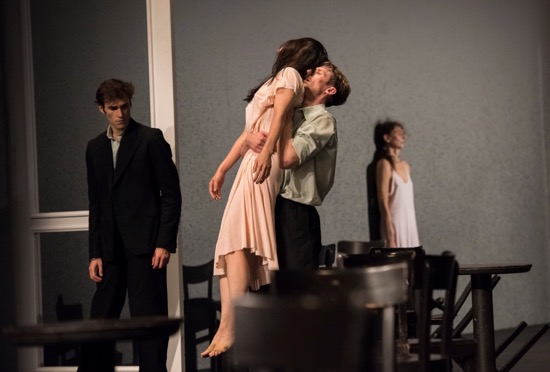
Tanztheater Wuppertal Pina Bausch in Café Müller. (L to R): Pau Aran Jimeno, Azusa Seyama, Scott Jennings, and Helena Pikon. Photo: Stephanie Berger
Compared with most Bausch works we’ve seen, Café Müller is a miniature. Its setting by Bausch’s then colleague and lover, Rolf Borzik, is a bleak restaurant after hours. Three doors punctuate its solid gray walls; one of these—wide and glassy—shows the outside. We presume another door, hidden behind a panel at the back. At some point, we can see through the main door into actions happening beyond the large room. The chairs are wooden, the tables, small, round, and scattered about. As a child, Bausch must have spent time in her parent’s café, whether patrons were there or not.
What I didn’t see clearly in 1984 is the expertise with which Bausch jumbled together, displaced, and layered the actions of the six people who frequent this place and stride or rush in and out of it. It’s as if we’re seeing an analogue to the stews that might emerge from the kitchen; elements float to the surface and sink down, a current stirs them into juxtaposition or breaks them apart. In one of two casts, Helena Pikon (as tall and thin as Bausch was in the role) is a sleepwalker, her straight arms pushing downward and slightly ahead of her. (She’s strangely inefficient; her fragile fingertips would hit an obstacle first.) The way she bangs against a wall and stays there a while conflates a safe boundary with a barrier. Azusa Seyama (Beatrice Libonati in 1984) is also barefoot, and dressed, like Pikon, in a long, pale, clinging garment, almost a nightgown; she too, at times, gropes her way, unseeing. She too bangs against a wall.
Pau Aran Gimeno assumes the role that Borzik himself played at the work’s 1978 premiere. (How suitable for the set designer to be watchful in case these women hurt themselves!) Gimeno hastens after one or the other of the women, thrusting tables out of the way and toppling chairs to create clear pathways. Over the course of the dance, it becomes harder and harder for him to do this efficiently. No matter; he keeps at it.
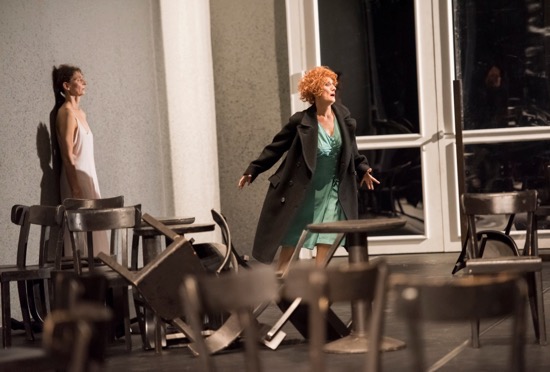
Helena Pikon (L) and Nazareth Panadero in Pina Bausch’s Café Müller. Photo: Stephanie Berger
A third woman (played in one of the two casts by veteran Bausch performer Nazareth Panadero) also has a single task—or perhaps task is the wrong word, since no clear goal is immediately evident. She’s wearing high heels and a black coat over her dress, and she toddles in and out of the action with busy, but inefficient little steps, as if she’s constantly checking things. Imagine a busy mother or grandmother, periodically looking into the room where the kids are playing to make sure everyone’s okay. She, like Aran Gimeno, is watchful every second she’s onstage, sometimes hovering as if wanting to help but not knowing how to do it. Just before the end, she takes off her coat and shoes and, her back to us, begins a sly fragment of a dance.
The dancing of Pikon and Seyama is sensuous in a different way; they’re self-absorbed, dreamy. Each may wreathe an arm around her head or slip both arms around each other as if tying silky knots. Each bends her body lavishly sideways. The music that intermittently pits the silence and the toppling of chairs is drawn from Henry Purcell’s opera Dido and Aeneas, and it seems to get under the skins of these two (or perhaps one woman and her remembered self). “Oh let me,” sings the recorded soprano voice, “ohhh let me, let me weep.”
The other two characters are men (Jan Minarik and Dominique Mercy in the original production and in Brooklyn in 1984). One (Michael Strecker) wears a dark suit and moves stolidly and purposefully. The other (Scott Jennings) is garbed in trousers and a loosely fitting white shirt. The strongest image that lodged in my mind in 1984 was of a many-times repeated act involving those men and one of the women. It goes like this. Jennings and Seyama stand embraced. Strecker, about to leave, notices this and turns back. He carefully rearranges Jennings’s arms to create a ledge, re-drapes Seyama’s around her partner, presses their mouths together, and lifts her into Jennings’ now-ready support. He’s almost out the door when Jennings lets his arms go limp; Seyama falls to the floor, but immediately recovers into the pair’s original embrace.
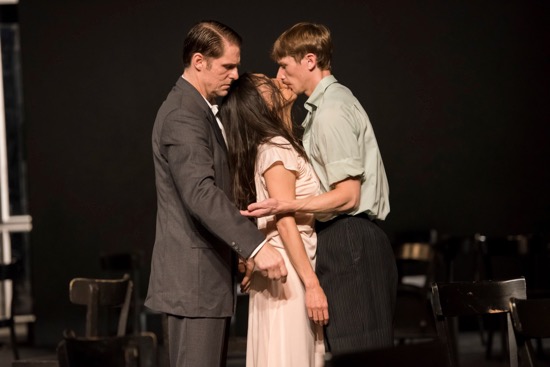
(L to R): Michael Strecker, Azusa Seyama, and Scott Jennings in Pina Bausch’s Café Müller. Photo Stephanie Berger
Like an impatient teacher or father, Strecker starts the whole process again. And again and again and again and again. . . . The action escalates. Perhaps Jennings is tiring; he drops Seyama sooner and sooner, and she recovers with increasing alacrity; Strecker has to race to reinstate, in slapdash haste, the position he approves of. I didn’t think in 1984, that perhaps this authoritarian character wishes the woman to remain a child. Or perhaps he wants to give her away. Nor had I remembered that the man played by Jennings soon becomes addicted to falling himself—collapsing loosely over and over and over (does he want to know what Seyama has felt?). And I had forgotten that, at least once, Seyama stands alone somewhere else, being embraced when there’s no one near her.
This time, when the lights are almost out, I see in the dimness something I never saw before: Panadero is gently draping her coat over Pikon’s shoulders. Maybe she’s taking her home. Wherever that is. In the darkness, we hear the scrape of a chair against the floor.
I’ve mentioned the names of the performers I saw in 1984 because they were so memorable that the fine performers I see in 2017 harbor their ghosts.
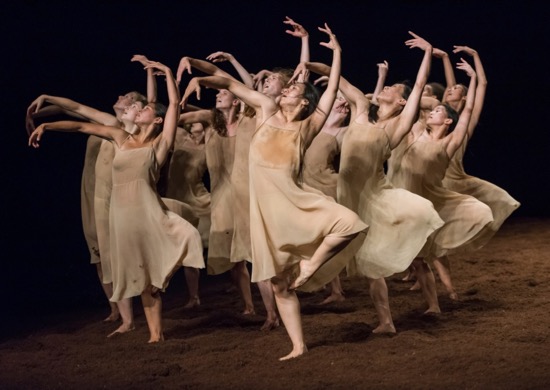
The women of Tanztheater Wuppertal Pina Bausch perform The Rite of Spring. Photo: Stephanie Berger
Bausch made The Rite of Spring while she was busy creating dances for the operas shown in the Wuppertal Opera House. It was one of three works to music by Stravinsky that she staged in 1975 and revived in 2013 for a program honoring her company’s 40th anniversary. (A reconstruction of the opening piece, Wind from the West, was presented in New York by Juilliard Dance in December of that year.)
Stravinsky’s epochal score led Bausch from the beginning of a ritual to its ending. It’s not the kind of music a choreographer can easily ignore. What the composer wrote for Njinsky’s 1913 Le Sacre du Printemps shocked the Parisians who attended Serge Diaghilev’s Ballets Russes as much as the “primitive” choreography did. Nijinsky and Stravinsky naturally conceived the ritual as anchored in dancing, and Bausch had to rise to that challenge. She did so magnificently. Her work is more violent, more primal than that of any other choreographer using that music (that is, any that I’ve seen).
The stage design by Borzik (who died in 1980) contributes greatly to its power. Those of us who didn’t leave our seats at intermission got to see the site being prepared. Only instead of village elders and their servants, we watched a small army of black-clad stage technicians spread a groundcloth, staple-gun it down, and, side by side, trudge across it to smooth out any wrinkles. Then they wheeled in six (or was it eight?) containers and, on cue, tipped them to dump loads of red-brown peat on the floor, and, in their own kind of dance, smooth it out with rakes.
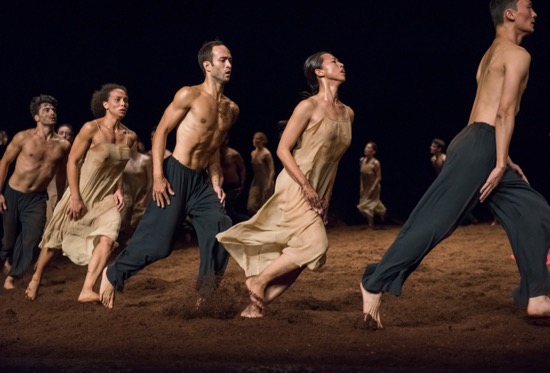
The throng in Pina Bausch’s The Rite of Spring circles the ritual space. Photo: Stephanie Berger
It’s the women in the piece that we see as individuals, even though they perform dances as rhythmically thumping and thrusting as the men and are crucial in the big wheeling circle with which all 36 performers enclose the ritual space to the sound of a heavy-footed passage of music. They are the first to answer to Stravinsky’s quiet summons—one by one, or in twos and threes. They cluster to confer, wander about, seem to anticipate what’s to come. Occasionally one of them pulls her dress up, as if thinking of taking it off. The red piece of fabric that one woman is lying on when the lights come up will turn out to be the garment that the chosen one will wear. Having watched a video of this intermittently over the years, I never noticed until now that much of the dancing that the women do tells us that they are practicing the steps of the climactic ritual for which one of them will be selected.
Once the men arrive, the participants separate by gender into two tight-knit squads. The dancing is as ferocious as the crashing music. The performers stamp, feet wide apart; they fling themselves into the air; they charge across the space. On a final loud crack of sound, they fall face down. As the piece winds toward its inevitable end, Borzik’s earth adds its own grim touch. It sticks to the sweating, bare-chested men, begrimes their hands and faces, soils the women’s flimsy dresses.
Suddenly we’re aware of one man (Julien Stierle) who is standing still: the leader, the shaman. We begin to notice individual women. Seyama has a brief outburst, is watched, stalked. Ophelia Young gets Stierle’s attention; he feels her body, but she runs away. The crisis mounts when the quaking women huddle together, and now one, now another approaches the waiting priest, holding the bundled-up red dress. Each in her own way runs back into the group—frightened, or rejected by the immobile man in charge, whose face we can’t see.
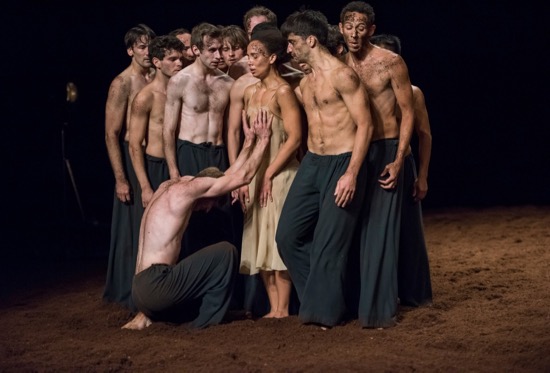
Julian Stierle (kneeling) with Ophelia Young and the male ensemble of Pina Bausch’s The Rite of Spring. Photo Stephanie Berger
As soon as he grasps one (Tsai-Chin Yu), the ritual takes another turn. The women spraddle the men and are twisted this way and that in a stylized, pre-ordained rape. Terrifyingly, they launch themselves into the air and end up seated on a partner’s shoulder. Stierle pushes small, resistant Yu toward the men and leans her out toward them. In the midst of a dancing storm, his back turned to us, he conceals her while he garbs her in the red dress. Then he lies on his back, both arms raised, and waits, while Stravinsky’s music begins its shudderings and outcries. Everyone else watches without emotion the final dance. Almost every movement we’ve seen so far reappears transformed by ordeal. As in those performances of the piece that I’ve seen one of the straps of the maiden’s dress breaks, so that one of her breasts is bare, somehow rendering her even more vulnerable (I once thought this effect was accidental).
The sacrificial dance is a long one—arduous for the dancer as well as terminal for the character. Nijinsky and Stravinsky may not have made this connection, but watching Yu’s wrenching portrayal of Bausch’s victim-heroine, you can think of the sacrifices that dancers make and the ordeals they undergo in the life span of their careers.
At the performance I attended, the audience consisted of many more young people than usual at BAM, and people seemed not only thrilled but flabbergasted as they stood to applaud the wet, grimy, exhausted dancers, who— as always with Tanztheater Wuppertal’s heroic performers—bowed gravely, breathing hard. Pina would have been proud.

I have unfortunately not seen the company live for decades, but have watched the Wenders film with awe and wonder several times (once in 3D!). I note you don’t mention any comparison to the filmed segments of Cafe Muller and Rite of Spring. What did you think of what we saw of them in the film? I would assume that seeing these live would pack even more of a punch!
I saw both pieces onstage first, so my perception of Wenders’ film was influenced by that experience. Of course, the film enabled me to focus on details that I might have missed when I watched the dances live.